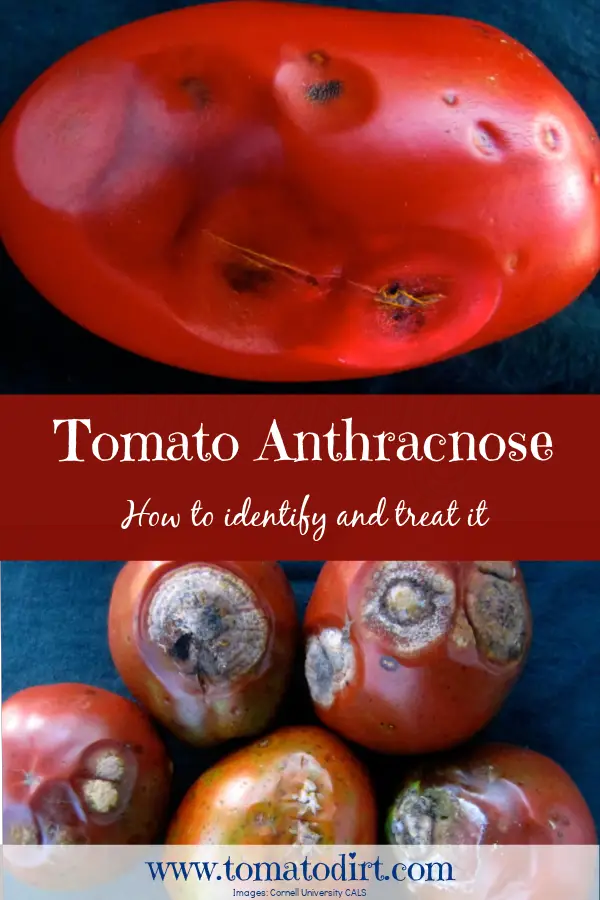FREE: 10 Must-Know Tomato Growing Tips Get The Guide
Read our affiliate disclosure here.
Tomato Anthracnose: How to Identify and Treat It
Since 2010, Tomato Dirt has garnered 4.8+ million views, making it the web’s leading online source for growing tomatoes in the home garden. Award-winning writer and Tomato Dirt owner Kathy Widenhouse has helped thousands of home gardeners grow healthier tomatoes. Be one of them when you get Tomato Dirt’s Growing Guide here.
Updated 7.9.24
Tomato anthracnose (an-thrak-nohs) is a type of tomato rot that affects ripe and overripe fruit. It’s one in a group of fungal diseases that affect s a wide range of plants. In tomatoes, the culprit is the Colletotrichum phomoides fungus.
What does tomato anthracnose look like?
You’ll recognize anthracnose in small, found soft spots that develop on the surface of the tomato. At first, the spots may appear as soft depressions. The circles can grow larger over time. They may even develop concentric rings. Left unchecked, anthracnose causes the fruit to rot.
What causes tomato anthracnose?
At the end of the season, compact masses of the fungus (called sclerotia) survive in soil. They can remain there for to three years. Fungal spores release in wet or humid weather. They spread easily through water that splashes on plants and fruit.
When does tomato anthracnose affect plants?
The fungus is most common in ripe and overripe tomatoes – both those on the vine and those that have been picked. Only very occasionally will green tomatoes be affected by anthracnose.
How can you control and treat tomato anthracnose?
Apply fungicide (following manufacturer’s instructions) when tomatoes are the size of a walnut.
Products will have the best impact when used in temperatures of 65 degrees F.
Reapply fungicide every two weeks and after rain.
(How to choose and apply fungicide to tomato plants.)
How can you prevent anthracnose in tomatoes?
- Rotate crops.
- Plant tomatoes in well-drained soil. Anthracnose thrives in moist ground.
- Trellis tomato plants for better air circulation.
- Mulch tomato plants with straw or black plastic to create a stronger barrier between fungi in the soil and fruit on the plants.
- Water plants at the base of the soil, rather directly on leaves or fruit, to prevent the spread of the fungus. Water early in the day so that any moisture that splashes on plants can evaporate before darkness falls.
- Pick tomatoes as soon as they ripen. The fungus spreads easily in ripe or overripe fruit.
- Remove affected fruit from plants and from the ground and destroy it. This way, fungi won’t remain in the ground and accumulate into masses of sclerotia.
Other facts to know about anthracnose
In the vegetable garden, anthracnose can cause damage to beans, cucumbers, watermelon, squash, melon, and peppers.
In the landscape, anthracnose causes lesions on leaves and branches of deciduous trees, including ash, basswood, elm, maple, oak, sycamore, and walnut.
More tomato problems on fruit
Blossom end rot: how to identify, treat, and prevent it ...
Why a tomato cracks and what to do about it ...
What causes mealy tomatoes and what to do about it ...
Tomato sunscald: why too much sun can be hazardous to tomatoes...
Fungicide for Tomatoes: A Primer ...
Help! My tomatoes have green shoulders ...
Gray wall on tomatoes: blotchy ripening on fruit ...
Stink bugs: how to identify and control them on tomato plants...
Tomato fruitworms: how to identify and control them ...
Tomato diseases: how to identify, control, and prevent them ...
Get more tips on our Tomato Problems Pinterest board...
Return from Tomato Anthracnose to Tomato Dirt home
As an Amazon Associate and Rakuten Advertising affiliate I earn from qualifying purchases.
SHARE THIS PAGE:
FREE! 10 Must-Know Tomato Growing Tips: 20-page guide
Get yours here:




